

| The Harvestmen of Worksop in October 2012 |
| If you want to go looking for
invertebrates, then the centre of Worksop in
Nottinghamshire would probably not be top on your list of
possible sites and especially not in early October. With
the Sherwood Forest National Nature Reserve and the
expanse of the National Trust's Clumber Park just minutes
down the road, why would anyone chose Worksop? But if you want to see a variety of Harvestmen with very little effort, then you cannot do a great deal better than a visit to the Prospect Estate in Worksop. To be honest, Worksop does seem to have a good population of Harvestmen within its urban areas, even producing a surprising first ever UK record of the invasive and still as yet un-named Leiobunum sp. A, back in 2009. |
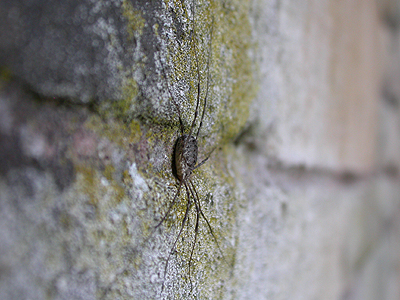 |
|
| ...... | ||
| Leiobunim sp. A is a very long-legged Harvestman, but obviously very different to the UK's other Leiobunum Harvestmen on size alone. The male we found on a house wall on the Prospect Estate back on October 13th 2009, was to remain unidentified for two years and it wasn't until searching for images of another recent UK colonist (Leiobunum rupestre), that we found images of an unknown invasive Harvestman and which matched our specimen perfectly. Photographs of the Worksop specimen were sent to experts in the UK and Germany, who confirmed our suspicions that our Harvestman was the UK's first record of Leiobunum sp. A. It has also recently been found by Paul Richards on a factory wall at Barnsley, Yorkshire in September 2012. | ||
| ...... | ||
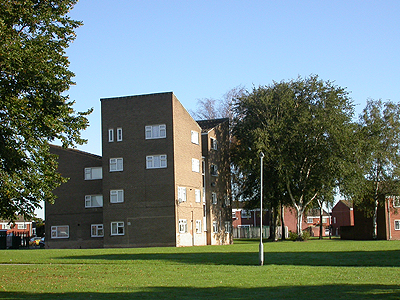 |
Confirmation that we had
indeed found an invertebrate completely new to the UK at
Worksop in October 2009, unfortunately coincided with the
onset of a period of cold weather in early December 2011,
and a return visit to survey the area proved negative. We had thought that after two years since we first recorded Leiobunum sp. A, it would be sat on most house walls in the area of the original record by now and in late September 2012 we tried again and still had no luck. Fine weather over the weekend of October 6-7th 2012, meant that conditions were again suitable, but despite several hours searching each day and some suspicious looks from local residents, we had to return home failing to get the target species. But despite us still not finding Leiobunum sp. A this time, we were still able to gather a good set of records involving several other species of Harvestman. |
|
| ...... | ||
| Over the course of the last century, the UK has seen the arrival of several new Harvestmen. Leiobunim sp. A and Leiobunum rupestre have both already been mentioned, but the invasive Opilio canestrinii has spread rapidly northwards since first being found in 1999, although nationally, records are still rather thin on the ground. | ||
| ...... | ||
 |
In the garden of a
terraced house on the Prospect Estate shown in the above
left and left hand photographs, O. canestrinii was
regularly found on our visits to one house there over the
past few years. But interestingly, it still seems not to
have affected the local population of Opilio
parietinus, in the way it reportedly has in other
areas of the UK. So invasive is O. canestrinii, that at many sites it has seemingly wiped out the local O. parietinus population, yet it seems to have had no visible impact on the number of O. parietinus present at Worksop, where it is still common. The same situation occurs around our home town of Market Warsop, just nine miles south of Worksop. We only very rarely record O. canestrinii and O. parietinus is still found commonly on a range of walls around the town. As common as O. parietinus is here, just about the commonest large Harvestman found in late Summer and Autumn is Phalangium opilio. |
|
| ...... | ||
| This large Harvestman is
often on many house walls around the Prospect estate we
visit and also turned up (along with O. parietinus)
on the sandstone walls of Worksop Priory Gatehouse during
surveying for Leiobunum sp. Harvestmen typically rest with their body tucked into a shallow depression in the brickwork and with their legs radiating outwards. During our surveying, it was noticed that Phalangium opilio females would be found higher up the walls than the males. Males sometimes showed signs of loose congregation, but were usually always found little more than 30cm off the ground. The Gatehouse dates back to the early 1400's and is situated at the junction of Priorswell Road and Cheapside, Worksop. Its old walls are good for Harvestmen, and apart from a solitary female Odiellus spinosus, the main occupants in October 2012 were small numbers of Phalangium opilio and Opilio parietinus. |
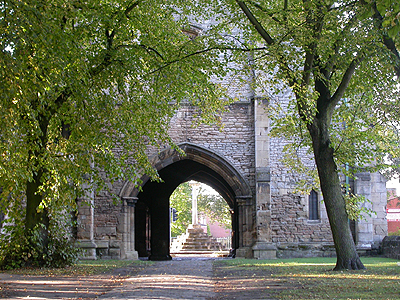 |
|
| ...... | ||
| Odiellus spinosus has the largest body of all our Harvestmen and is a relatively easy species to identify. With a near 1cm body length, the body flattened and having much shorter legs than P. opilio, O. canestrinii and O. parietinus, Odiellus spinosus is often found along the mortar layer, tucked up against the edge of a brick. On the Prospect estate, it is surprisingly common, but we rarely find this species away from Worksop and have just a single record from our house at Market Warsop, but none from anywhere else. | ||
| ...... | ||
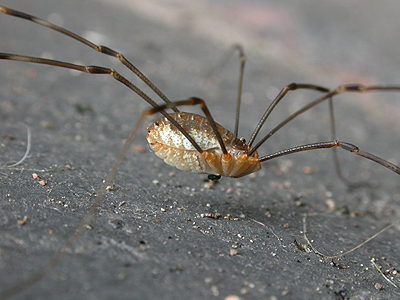 |
 |
|
| ...... | ||
| Four of the most regular Harvestmen in urban Worksop, are shown in this set of photographs. Thorough searches of walls in any urban location, may well reveal all these species. Above left is the attractively coloured Opilio canestrinii, above right is Opilio parietinus. Below are Paroligolophus agrestis (left) and Odiellus spinosus. | ||
| ...... | ||
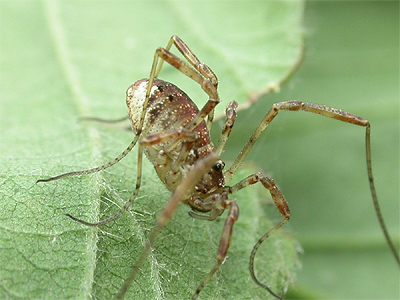 |
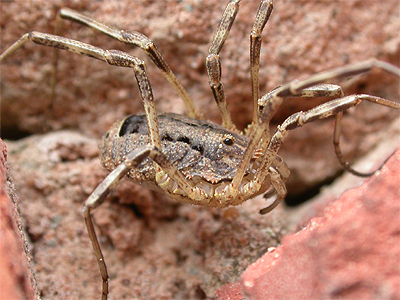 |
|
| ...... | ||
| Dicranopalpus ramosus (below) is another Harvestman to reach the UK over the course of the last century and was first recorded in 1946. Originally of Mediterranean origin, D. ramosus now has a range taking it high into Scotland. Of all our Harvestmen, it is probably the easiest to identify when at complete rest, holding all eight legs at right angles either side of the body. At home in the arboreal canopy, it has become one of our commonest species locally, yet during our Worksop surveys of October, D. ramosus was found to be totally restricted to the walls of Bassetlaw Hospital, but then only on a later survey conducted on October 13th. | ||
| ...... | ||
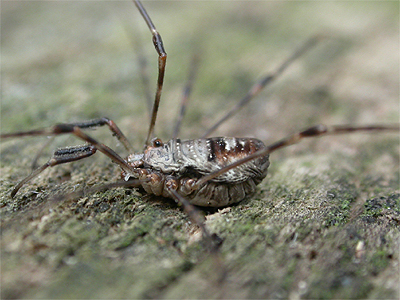 |
October 13th was
significant, marking the date on which we first found Leiobunum
sp. A back in 2009. We actually only realised the
closeness of the date when researching and starting to
write this article on October 12th 2012, but it suddenly
became an amazing coincidence when we returned to Worksop
for one more search. The weather forcasters had predicted showers on October 13th 2012, but after being cloudy and dry all morning, the sun began to break through and we thought of going back up to Worksop for another Harvestman survey and hopefully to find our elusive quarry. Our first stop was a roadside wall on an industrial estate on Sandy Lane, where we hoped that Leiobunum sp. A had originated from one of the units there via importation. Unfortunately, the wall turned out to be devoid of any Harvestmen at all and so we moved on. |
|
| ...... | ||
| Next it was on to Bassetlaw Hospital, where we soon found several adult Phalangium opilio, Dicranopalpus ramosus and singles of Opilio parietinus and a surprising record of Leiobunum blackwalli. Not the Leiobunum species we were after of course, but retaining the specimen did eventually come to prove quite useful. | ||
| ...... | ||
| Our next target area was
the Prospect estate. Again, very thorough coverage of all
shaded walls produced numbers of Phalangium opilio
and Opilio parietinus, with a few Odiellus
spinosus hiding in the deeper recesses within the
brickwork. By now, we had started to give up hope and looking for somewhere new to search. We tried a couple of old brick built factories on Priorswell Road, before going to have another look on the walls of Worksop Priory and Gatehouse. The Gatehouse once again held a few examples of Phalangium opilio and Opilio parietinus, but then we found a male Leiobunum blackwalli by the door to Worksop Priory. Not having many photographs of L. blackwalli, I took the opportunity to try and obtain more and it was thanks to the extra time spent taking photographs, that Dilys found a much larger Harvestman further along the wall. |
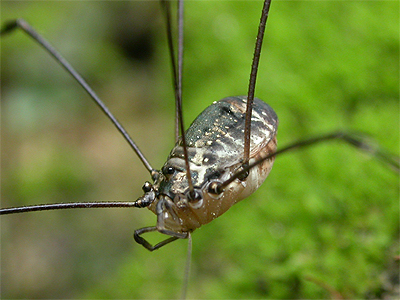 |
|
| ...... | ||
| It was instantly recognisable as being Leiobunum sp. A (above right) and after much effort, we had finally been rewarded with our target species. Some documenting photographs were taken, before we carried out a more detailed search of the Priory walls we could access. We were immediately successful and went on to record a total of 13 males and nine females along the southern wall of the Priory. All the Leiobunum sp. A we found were more or less at eye level and clearly preferred vertical joints or recesses built within the Priory walls. | ||
| ...... | ||
|
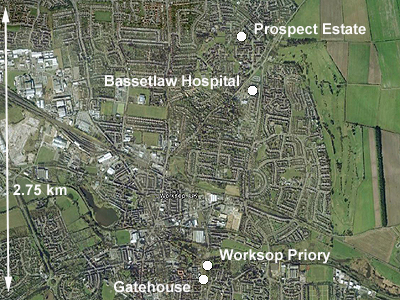 |
|||||||||||||||||||||||||||||||||||||||||||||||||||||||||||||||||||||||||||||||||||||||||||||||||||||||||||||
| ...... | ||||||||||||||||||||||||||||||||||||||||||||||||||||||||||||||||||||||||||||||||||||||||||||||||||||||||||||||
| What is
interesting about this short series of surveys, is that
even with a limited amount of surveying, an impression is
soon gained as to the distribution of any single species,
or a selection of species within a relatively small area.
Phalangium opilio and Opilio parietinus
were the most widespread Harvestmen at all the sites we
surveyed. In the above table, we have included Worksop Priory and the Gatehouse as the same site, yet we only actually recorded two species on the Gatehouse, compared to five found on the Priory itself. Interestingly, out of a total of 40 adults of all species recorded on the Priory walls, all but six were found on the warmer southern wall, though only Opilio parietinus and Phalangium opilio were exposed to full sun. When looking at the distribution of records for Leiobunum sp on Worksop Priory, we found 20 on the southern wall and singles on the northern and westerly facing walls. The range of Dicranopalpus ramosus was also interesting in that our surveying saw it recorded on the smooth brickwork of Bassetlaw Hospital, yet we never found it on any of the house walls on the Prospect Estate just across the road, so although it is undoubtedly common around the urban areas of Worksop, it's present distribution would seem to be patchy. Similarly, Odiellus spinosus was found to be confined to the Prospect Estate and not recorded at any of the other sites. |
||||||||||||||||||||||||||||||||||||||||||||||||||||||||||||||||||||||||||||||||||||||||||||||||||||||||||||||